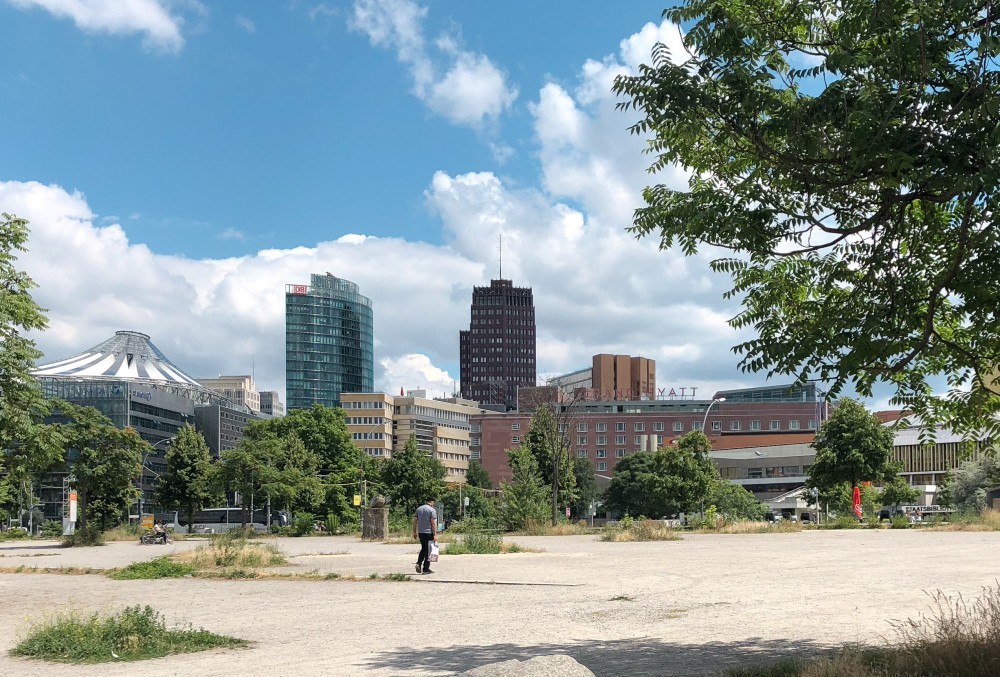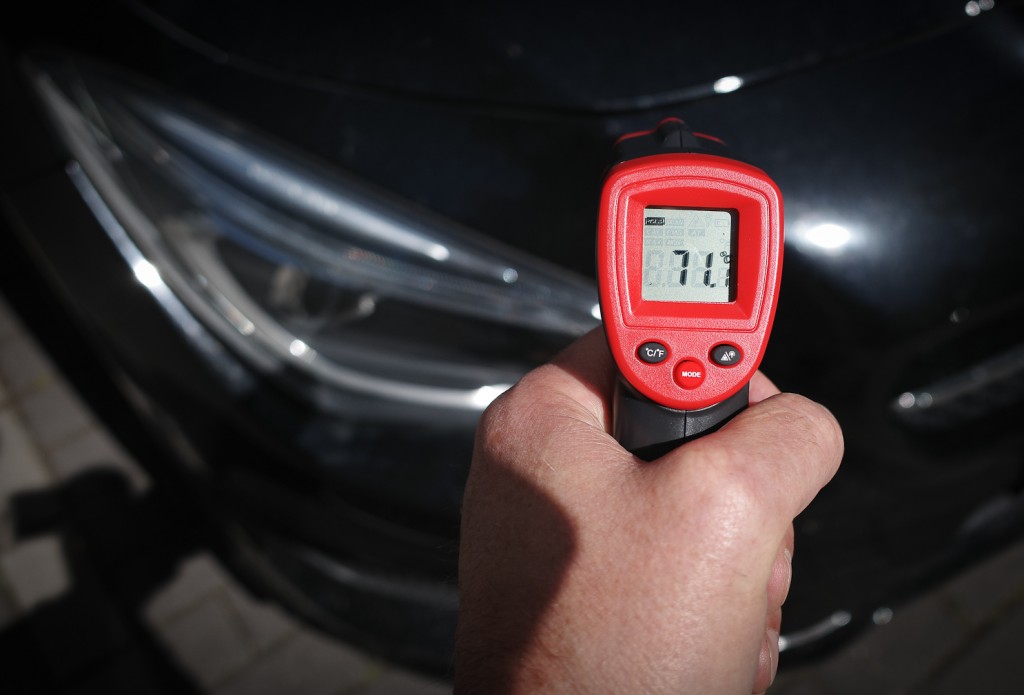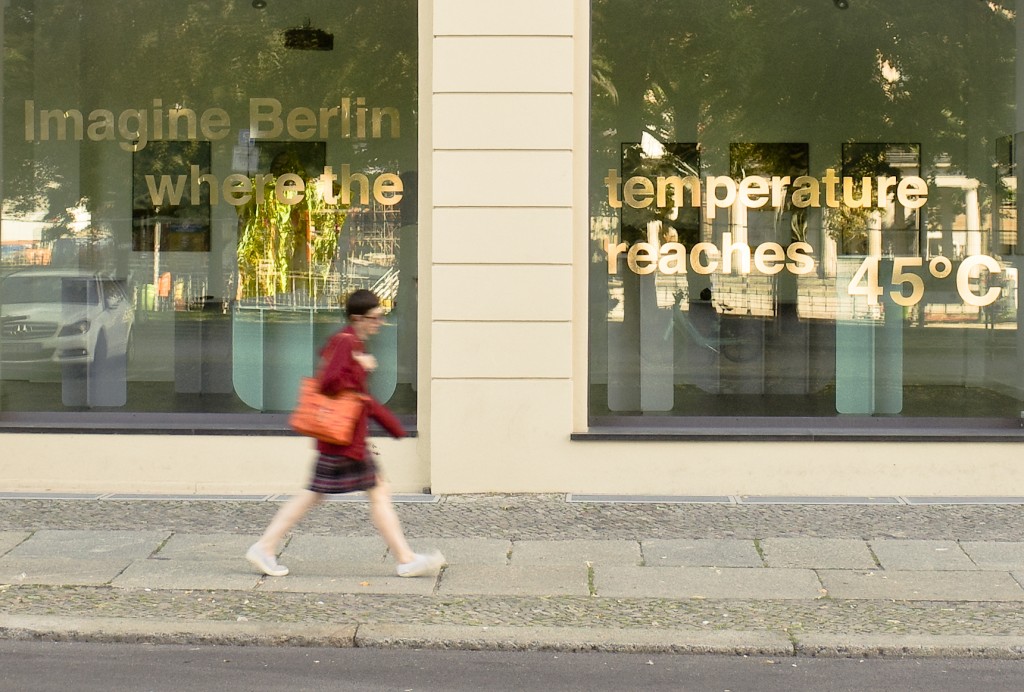Situation and future perspectives
Increasing climate warming is the outlook for northeastern Germany. More extreme droughts and changes in precipitation patterns will bring heavy rainfall and storms with high wind speeds. The resulting costs will increasingly burden the budgets of cities and businesses.
The Potsdam Institute for Climate Impact Research (PIK) has stated:
“The Spree metropolis is one of the most endangered cities in Germany”.
In relation to the surrounding area, the city forms a warm island, where on hot days the temperature peaks 4 to 5 degrees Celsius higher than in the region. This exacerbates summer heat stress. The media tend to focus on the visible damage caused by fallen trees (on parked cars), blocked roads, and downed power lines. Much more serious are the public health effects of heat waves.
Open spaces vs further addensification: Kulturforum area 2018 vs 2021. Photo: C. Hajer
In the conclusion of its project AFOK (Adaptation to the Consequences of Climate Change) of 2016, the PIK states::
“It is essential to educate urban society about the coming risks and to make it clear that and, above all, how action can be taken – also by each and every individual”
Fritz Reusswig, PIK Potsdam, 2016
Policy
In 2011, the Senate Department for Urban Development and Environmental Protection will adopted the “Urban Development Plan (StEP) Climate”, an informal planning tool to sensitize and inform experts and the general public. This was followed by several publications with best practice examples of adaptation to climate impacts from various ministries.
2016 Adoption of a revised StEP Climate Action Plan, against the background of expanded scientific knowledge and the fact that the city’s growth is rapidly accelerating.
Climate adaptation in the city is now described as an integrated strategy: instead of providing separate subsidies for adaptation, measures are to be integrated into new projects in housing, commercial development, transportation planning, and green and open space design.
The strategy of the compact city, the “city of short distances” through subsequent densification, will be maintained during the process of urban transformation. The focus will be on the two weather extremes, drought and heavy rainfall, and the urban areas most affected. The selection and spatial focus of the measures is based on GIS-supported modeling of urban climate-relevant parameters on the basis of high-resolution building and vegetation data.
Measures
In 2016 a roadmap called “Stadtentwicklungsplan Klima Konkret” describes measures for adaptation to the consequences of climate change, In relationship to the specicic sensitivity the program describes six stepping stones for future developments:
– Roof design
– Facade design
– Increase of reflection (Albedo)
– Urban Wetlands for cooling
– Rainwater management to prevent flooding and overflow of sewers
– Cooling adapted to the time of day
The result of the election to the House of Berlin parliament in 2017 changed the layout of the Senate administrations. Since then, the Senate Department for the Environment, Transport and Climate Protection, SenUVK, has been responsible for climate protection, while a separate department has been established for urban development and housing, SenStadtWohn.
Further activities in climate protection and the reduction of greenhouse gases
The Berlin Energiewendegesetz (Energy Turnaround Act), which came into force in 2016, provides the legal framework for the city’s desired climate neutrality by 2050. Compared to the 1990 reference value, CO2 emissions are to be reduced by 40% by 2020 and by 60% by 2030. The city itself wants to set a good example in this respect: Senate and district administrations should organise themselves in such a way that they will be CO2-neutral by 2030.
In addition, Berlin is relying on international cooperation to exchange best practice measures and bundle effects.
In 2017, the Federal Ministry of Health called on the municipalities to draw up heat action plans to protect the population. The municipalities were slow to comply. Berlin is expected to present its heat protection plan on 20 June 2022.
In 2018, the Berlin Energy and Climate Protection Programme (BEK) is adopted. The BEK contains measures in the fields of energy, transport, buildings and urban development, business and private households and consumption for the implementation period up to 2020 and the development horizon 2030. It represents the “roadmap” on the way to climate neutrality by 2050. Climate impact monitoring is carried out to monitor and evaluate the further development of climatic parameters.
Civil society initiatives, such as the #FridaysforFuture demonstrations in Berlin’s government district, are putting additional pressure on federal and state politicians.
More: Germany participated at the Climate Adaptation Summit CAS2021 in January 2021.
On May 6, 2021, the governing coalition in the Berlin Parliament decided to establish a Climate Citizens’ Council based on an idea from France. This council is now to develop proposals and recommendations for a socially just and climate-neutral Berlin. A big success for the “Klimaneustart” initiative.
This had submitted 24,812 valid signatures for a climate citizens’ council. The Senate is now required to establish the Climate Citizens’ Council and to provide funding for work, moderation and scientific support.
The German Federal Ministry of Building, Housing and Urban Affairs (BMWSB) is funding the climate-friendly conversion of inner cities in Germany with 790 million euros in 2023.
Meanwhile health Minister Karl Lauterbach promised a nationwide heat action plan.




